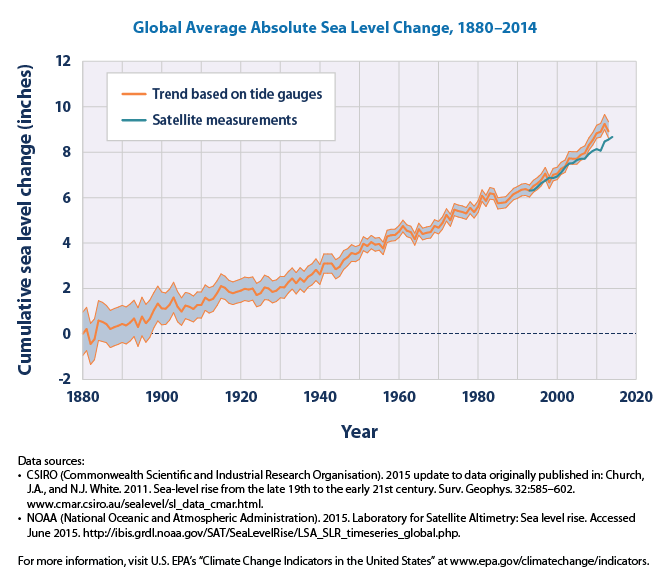
By US EPA [Public domain], via Wikimedia Commons
As I’ve worked on the previous editions of our textbook with Kim Brown, I’ve become increasingly convinced that it’s important for educators to recognize that our task is not only to teach about how humanity can prevent global warming, but also how humanity will need to adapt to climate change. There is now so much additional CO2 in the atmosphere that we are committed to global warming for generations to come. Perhaps no environmental impact will affect people as much rising sea levels, which is the central theme of Retreat from a Rising Sea.
The recurring point of this book is that retreat from the sea is inevitable. What is at issue is how orderly, expensive and painful this process will be. A key problem is human nature, which has blocked a realistic discussion of how this process takes place. As the authors discuss in chapter five, in the United States government policies have exacerbated the problem, by subsidizing coastal development, typically for second homes for the wealthiest in our society.
Ironically, in some poorer countries -like Colombia- this retreat from the sea is being managed much better because the nation does not have the resources to address the problem inefficiently. Hence, beach side houses are designed to be broken down and moved with a minimum of fuss; in the United States, U.S. government subsidies have encouraged high-rise developments to take the place of mom and pop shacks.
The authors have a skeptical vision of resilience, which they believe often elides the only realistic option, which is retreat. For this reason, the authors take a somewhat skeptical view of the Dutch approach, which is to engineer your way out of the problem. For all their expertise, and their willingness to cede some land, the Dutch too face a managed retreat.
The book has a wonderful series of color photographs, which sometimes make a point more effectively than any words could. The photos of England’s Holderness coast convey the scale of erosion that nation’s face. The final discussion of what has taken place on this coast over the last 2,000 years provides a chilling context to understand what will now take place much more quickly on a global scale.
It’s also impossible to discuss sea level rise without addressing the issue of migration. This may also be shaping government policy, as with the “Great Wall of India,’ which separates the country from Bangladesh. India knows that its neighbor will certainly face an outflow of refugees from low-lying regions. The wall may represent an effort to anticipate this problem.
For some parts of the United States, the picture is bleak. In chapter three, the authors discuss the future of Miami and New Orleans, for which there is no long term hope. But many other cities face immense challenges, including both New York City and Boston (Pilkey et al., p. 73). The situation is greatly worsened by great efforts by American businesses to conceal information about sea-level rise, as has been the case in North Carolina (Pilkey et al., pp. 150-154). Chapter 10 describes how industry lobbyists -sometimes the same people who worked to defend the tobacco industry- have sought to create doubt about global warming. The chapter provides a horrifying word-sketch of how money can pervert the public knowledge of science. Ironically, even some U.S. government institutions that are dedicated to studying climate change -such as NASA- are making decisions as if sea levels were not rising (Pilkey et al, pp. 120-122). The implications for America’s infrastructure are staggering. How can we understand Florida’s decision to build the Turkey Point nuclear plant at the water’s edge, (Pilkey at al., pp. 115-117), or even the St. Lucie nuclear plant on Hutchison island?
Last summer I did fieldwork around avian influenza and wet markets in southeastern China, for which I travelled to Hong Kong, Macao and Shenzhen. While in Macao I was stunned equally by the opulence of the casinos, and their location a stone’s throw (a very easy toss) from the Pacific Ocean. Why would any rational investor sink billions into property that will inevitably wash away, when there is higher ground a short distance away? For all their wealth, their advisers, their influence and their vision, these investors have wasted a staggering amount of money on property that rising waters will drown. The only possible explanation for their decision is denial, which is a common response to this overwhelming challenge. For this reason, not only students but also business people, politicians, policy makers, and citizens should read this well-written, concise and important work.
If you are curious to read more on this topic, you can find another post about sea level rise here.
